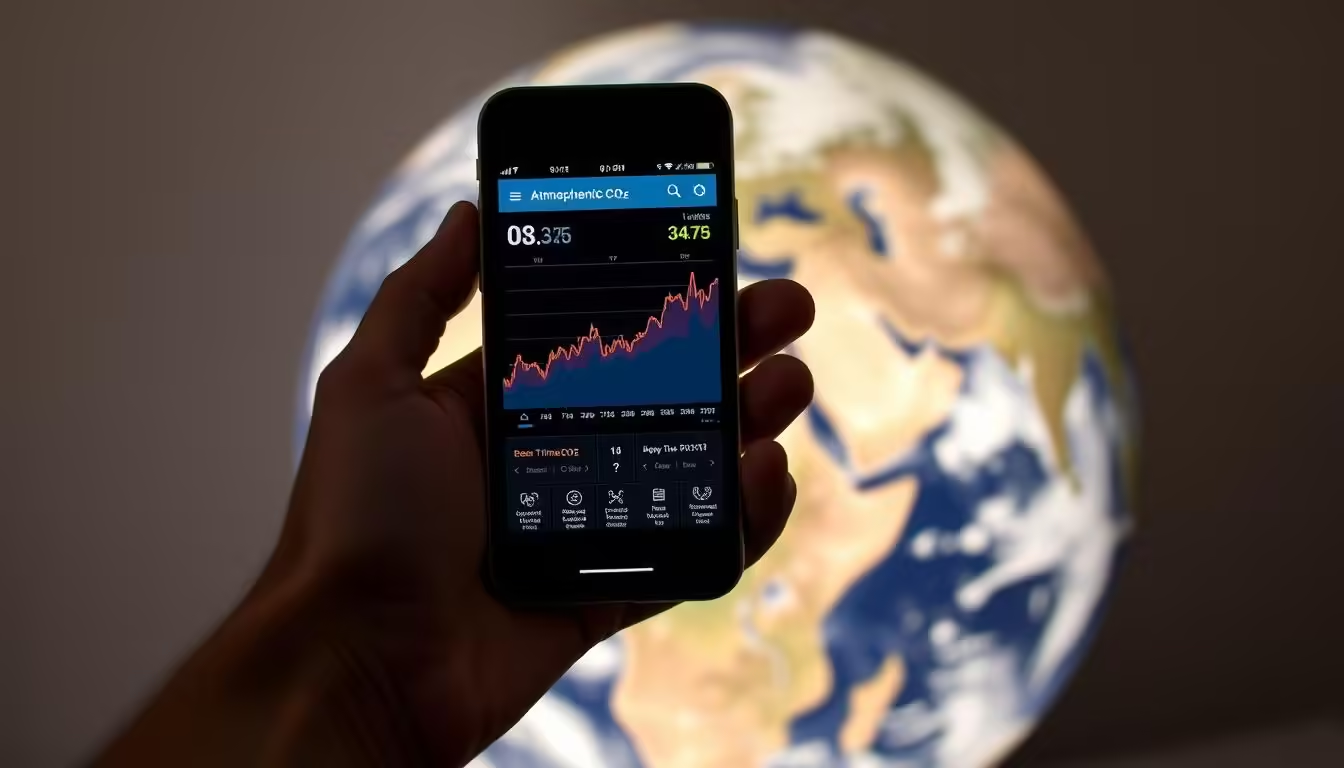Monitoring CO₂ levels has become more accessible thanks to mobile apps connected to global climate data. These apps allow individuals to track the concentration of CO₂ in the atmosphere, providing valuable insights into the impact of human activities on the environment.

By leveraging climate data, these apps contribute to a better understanding of climate change and its effects on sustainability. This information is crucial for making informed decisions about reducing our carbon footprint.
Key Takeaways
- Mobile apps can monitor CO₂ levels using global climate data.
- Tracking CO₂ concentrations helps understand human impact on the environment.
- Climate data insights support sustainability efforts.
- These apps make climate change data more accessible.
- Informed decisions can be made using the data from these apps.
The Rising Importance of Monitoring Carbon Dioxide Levels
With climate change being a pressing global issue, understanding and monitoring CO₂ levels is vital. The impact of human activities on the environment has led to a significant increase in carbon dioxide emissions, contributing to global warming and associated climate changes.

Understanding CO₂’s Role in Climate Change
Carbon dioxide is a greenhouse gas that traps heat in the atmosphere, leading to a rise in global temperatures. The increasing levels of CO₂, primarily due to burning fossil fuels and deforestation, have been identified as a major contributor to climate change. Understanding the role of CO₂ in climate change is crucial for developing effective mitigation strategies.
By monitoring CO₂ levels, scientists and policymakers can better understand the impact of human activities on the climate and make informed decisions to reduce emissions.
Why Personal Monitoring Matters
Personal monitoring of CO₂ levels empowers individuals to take action against climate change. By being aware of their carbon footprint, individuals can make lifestyle changes to reduce their impact on the environment. This collective action can lead to significant positive changes when combined with broader societal and governmental efforts.
Moreover, personal monitoring encourages a culture of sustainability and environmental stewardship, promoting a community-wide commitment to reducing carbon emissions.
How Mobile Technology is Transforming Earth’s Climate Monitoring
The advent of mobile technology has revolutionized the way we monitor Earth’s climate, making it more accessible and efficient. With the proliferation of smartphones and mobile apps, individuals can now contribute to and access climate data in real-time.
The Evolution of Environmental Monitoring Tools
Traditionally, environmental monitoring was the domain of scientists and researchers using specialized equipment. However, with the integration of Green Tech and mobile technology, the landscape has changed dramatically. Mobile devices now enable the collection of diverse data types, from air quality to CO₂ levels, using apps that can be operated by anyone.

Democratizing Access to Climate Data
One of the most significant impacts of mobile technology on climate monitoring is the democratization of access to climate data. Through various mobile apps, people can now access real-time data on Climate Change indicators, understand their Environment, and make informed decisions. This accessibility fosters a more engaged and aware public, crucial for addressing the challenges posed by Climate Change.
Furthermore, the use of mobile technology in climate monitoring encourages community involvement and participation in environmental conservation efforts. By leveraging Technology, we can build a more sustainable future.
Top Mobile Apps for Tracking Earth’s CO₂ Levels
Climate change awareness has prompted the creation of various mobile apps designed to track and monitor Earth’s CO₂ levels. These apps not only provide real-time data on carbon dioxide concentrations but also offer insights into climate change and its impacts on the environment.
NASA’s GEOS App
NASA’s GEOS App is a powerful tool for monitoring Earth’s atmosphere. It provides users with real-time data on CO₂ levels, along with other atmospheric components.
Key Features and Data Sources
The app’s key features include real-time global modeling and data assimilation. It sources its data from NASA’s Goddard Earth Observing System (GEOS).
User Experience and Accessibility
The app is designed to be user-friendly, making it accessible to a wide range of users, from scientists to the general public.
Carbon Footprint Calculator Apps
Carbon footprint calculator apps help individuals and organizations track their emissions. They provide personalized recommendations for reducing carbon footprints.
Personal Emissions Tracking
These apps track daily emissions based on user inputs such as energy consumption, travel, and lifestyle choices.
Reduction Recommendations
They offer tailored advice on how to reduce emissions, including energy-efficient practices and sustainable lifestyle changes.

Earth Observer and Climate Trackers
Earth observer and climate tracker apps provide comprehensive data on Earth’s climate. They often include features for monitoring CO₂ levels, weather patterns, and more.
Global Monitoring Capabilities
These apps have the capability to monitor climate parameters globally, offering a broad perspective on climate change.
Visualization Tools
They include visualization tools that help users understand complex climate data through interactive maps and graphs.
| App Name | Key Features | Data Sources |
|---|---|---|
| NASA’s GEOS App | Real-time global modeling, data assimilation | NASA’s GEOS |
| Carbon Footprint Calculator | Personal emissions tracking, reduction recommendations | User inputs |
| Earth Observer | Global monitoring, visualization tools | Various climate databases |
Citizen Science Platforms
Citizen science platforms engage the public in climate monitoring. They allow users to contribute to and access climate data.
Collaborative Data Collection
These platforms facilitate collaborative data collection efforts, enabling a wider understanding of climate phenomena.
Community Engagement Features
They include features that foster community engagement, such as discussion forums and project sharing.
Air Quality and CO₂ Monitoring Apps
Air quality and CO₂ monitoring apps focus on local and global air quality. They provide information on CO₂ levels and other pollutants.
Local vs. Global Measurements
These apps often differentiate between local and global measurements, giving users a nuanced view of air quality.
Health Impact Information
They also provide information on the health impacts of air quality, helping users make informed decisions.
How These Apps Connect to Global Climate Data Networks
The connection between mobile apps and global climate data networks is revolutionizing how we monitor Earth’s CO₂ levels. By leveraging advanced technology and global data networks, these apps provide users with real-time insights into climate change.

Satellite Integration and Real-Time Monitoring
Satellite integration plays a crucial role in climate monitoring. Satellites orbiting the Earth capture vast amounts of data on CO₂ levels, which are then transmitted to global climate data networks. Mobile apps connected to these networks can access real-time data, enabling users to monitor climate change as it happens. Real-time monitoring is essential for understanding the dynamics of climate change and for making informed decisions.
The use of satellites in climate monitoring has significantly advanced our ability to track CO₂ levels globally. This technology, combined with mobile apps, represents a significant step forward in Green Tech innovations.
Ground Station Data Collection Methods
In addition to satellite data, ground station data collection methods provide another critical source of information on CO₂ levels. Ground stations are equipped with sensors that measure CO₂ concentrations in the atmosphere. This data is then fed into global climate data networks, supplementing satellite data and providing a more comprehensive view of climate change.
The combination of satellite and ground station data allows for more accurate monitoring and forecasting of climate change. Mobile apps that tap into these data sources empower users to stay informed about the Environment and take action against climate change.
The Science Behind Measuring Earth’s CO₂ Levels and Climate Change
Understanding the science behind measuring Earth’s CO₂ levels is crucial in the fight against climate change. As we discussed in previous sections, mobile apps play a significant role in monitoring CO₂ levels, but it’s equally important to comprehend the science that supports these technologies.
The measurement of CO₂ levels involves understanding the concentration of carbon dioxide in the atmosphere, typically expressed in parts per million (PPM). This measurement is critical because it helps scientists and policymakers track the progress of climate change mitigation efforts.
Understanding Parts Per Million (PPM) Measurements
PPM is a unit of measurement that represents the number of CO₂ molecules per million molecules of air. To put this into perspective, pre-industrial CO₂ levels were around 280 PPM. Today, they have surpassed 415 PPM, a significant increase that underscores the urgency of addressing climate change.
Measuring CO₂ in PPM allows for the tracking of changes in the atmosphere over time. This data is vital for understanding the impact of human activities on the environment and for developing effective strategies to reduce our carbon footprint.

Historical CO₂ Data and Current Trends
Historical CO₂ data provides valuable insights into how the Earth’s atmosphere has changed over time. By analyzing ice cores and other records, scientists have reconstructed CO₂ levels dating back hundreds of thousands of years.
| Year | CO₂ Level (PPM) | Change |
|---|---|---|
| 1960 | 316.9 | – |
| 1980 | 338.7 | +21.8 |
| 2000 | 369.4 | +30.7 |
| 2020 | 414.4 | +45.0 |
Interpreting the Data You See
When using mobile apps to monitor CO₂ levels, it’s essential to understand the data being presented. Look for trends rather than isolated readings, and consider the sources of the data to ensure accuracy.
By interpreting CO₂ data correctly, individuals can make informed decisions about their environmental impact and contribute to a more sustainable future.
Practical Uses for CO₂ Monitoring Apps in Sustainability Efforts
With the rise of green tech, mobile apps that track CO₂ levels are revolutionizing the way we approach environmental sustainability. These apps not only provide real-time data on carbon dioxide levels but also empower users to make informed decisions that contribute to a more sustainable future.

Making Informed Environmental Decisions
CO₂ monitoring apps enable individuals and organizations to track their carbon footprint and make data-driven decisions to reduce their environmental impact. By understanding their CO₂ emissions, users can identify areas for improvement and implement strategies to minimize their carbon footprint.
For instance, a company might use these apps to monitor the CO₂ emissions from their transportation fleet and decide to switch to more fuel-efficient vehicles or optimize their routes to reduce fuel consumption.
Educational Applications
These apps also have significant educational value, teaching users about the importance of reducing CO₂ emissions and promoting sustainable practices. Educational institutions can integrate these apps into their curricula to provide students with hands-on experience in environmental monitoring and sustainability.
| Educational Use | Description | Benefits |
|---|---|---|
| Curriculum Integration | Incorporating CO₂ monitoring apps into school curricula | Hands-on learning, real-world applications |
| Project-Based Learning | Using apps for student projects on sustainability | Enhanced engagement, practical skills |
| Community Engagement | Engaging local communities in CO₂ monitoring efforts | Raises awareness, fosters community action |
Community Science Initiatives
CO₂ monitoring apps can also facilitate community science initiatives by enabling citizens to contribute to environmental monitoring efforts. By collecting data from various locations, these apps help build a more comprehensive picture of CO₂ levels and their impact on local environments.
Community-driven projects can raise awareness about environmental issues and promote collective action towards sustainability. For example, a community might use a CO₂ monitoring app to track air quality during a local event and use the data to advocate for cleaner practices.
Green Tech Innovations in Climate Monitoring
The green tech revolution is transforming climate monitoring with innovative solutions. As the world grapples with the challenges of climate change, advancements in green technology are playing a pivotal role in enhancing our ability to monitor and understand environmental shifts.
Next-Generation Sensors and Devices
One of the most significant developments in green tech is the creation of next-generation sensors and devices. These cutting-edge tools are designed to provide more accurate and real-time data on CO₂ levels and other environmental factors. For instance, low-cost air quality sensors are now being deployed in various parts of the world, enabling communities to monitor their local environment more effectively.
- Enhanced accuracy and sensitivity
- Real-time data transmission
- Low power consumption
- Compact and portable design
“The future of climate monitoring lies in the intersection of technology and environmental science.”
AI and Machine Learning Applications
Another critical area where green tech is making a significant impact is in the application of AI and machine learning. These technologies are being used to analyze vast amounts of climate data, identify patterns, and predict future trends. For example, AI algorithms can process satellite data to track deforestation or monitor ocean health.
- Improved data analysis capabilities
- Enhanced predictive modeling
- Automated anomaly detection
By leveraging these technologies, researchers and policymakers can make more informed decisions about environmental conservation and climate mitigation strategies.
Challenges and Future Developments in Mobile Environmental Monitoring
As mobile environmental monitoring continues to grow, it’s essential to address the challenges that come with it. The increasing use of mobile apps to track Earth’s CO₂ levels and other environmental factors has brought about several issues that need to be resolved to ensure the continued effectiveness of these technologies.
Data Accuracy and Standardization Issues
One of the primary challenges facing mobile environmental monitoring is ensuring the accuracy and standardization of the data collected. Different devices and apps may use varying methods to measure CO₂ levels, which can lead to inconsistencies in the data. To address this, efforts are being made to standardize measurement protocols and calibrate devices to ensure accuracy.
Bridging the Gap Between Information and Action
Another significant challenge is translating the information gathered through mobile environmental monitoring into tangible actions. While having access to real-time CO₂ data is valuable, it is equally important to encourage individuals and communities to make environmentally conscious decisions based on this information. By integrating educational components into these apps and providing actionable insights, we can bridge the gap between data collection and sustainable practices.
Conclusion: Empowering Climate Action Through Technology
As we navigate the complexities of Climate Change, it’s clear that Technology plays a vital role in the quest for Sustainability. Mobile apps connected to global climate data have emerged as powerful tools, enabling individuals to monitor Earth’s CO₂ levels and make informed decisions about their Environment.
By leveraging Green Tech innovations, such as next-generation sensors and AI-driven insights, these apps provide a window into the health of our planet. They not only raise awareness about Climate Change but also empower users to take action, fostering a sense of community and shared responsibility for the Environment.
As we move forward, it’s essential to continue developing and utilizing these technologies to drive Sustainability efforts. By doing so, we can create a more environmentally conscious world, where Technology serves as a catalyst for positive change.
The future of climate action is in our hands, and with the help of mobile apps and global climate data, we can work together to protect the Earth and ensure a sustainable tomorrow.


